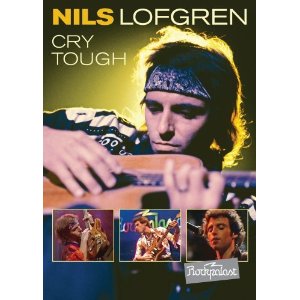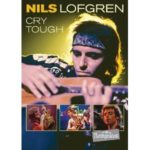
Eagle Vision
It wasn’t so noticeable until I watched Cry Tough, the two-disc set featuring three separate performances by Nils Lofgren and his bands on the German TV show Rockpalast, but the nearly 300 minutes demonstrate that he is an incredibly tasteful and underrated guitarist when given the opportunity to shine (“Girl in Motion,” “Valentine”). Yes, I’m familiar with him, as a teenager, he played with Neil Young and his days with Grin prior to moving on as a solo act. Still, I needed a reminder following more than two decades of submerging his talents for the good of the team. As a member of the E Street Band, he’s been swallowed up in its particular Wall of Sound behind Bruce Springsteen. It occasionally pops up, for example during the live solo in “Youngstown” but after this DVD one can’t help but wonder why the Boss doesn’t seek his services much more often.
Lofgren’s originals focus on back-to-basics rock ‘n’ roll that’s matched, similar to Springsteen, with a romanticization of the coupling of music and relationships. His subtle charm and passion for what he’s doing enables him to pull it off. At the beginning of the ’91 show, Lofgren begins solo acoustic on “Sticks and Stones” wherein he drops the revealing line of where his music stands – “Sticks and stones will break my bones/but your words, they break my heart.” It’s simple but poignant.
Already a music veteran in ’76, Lofgren confidently leads his band through nine tunes. Several years later, the members crank out a rousing instrumental to get people on their feet, and it works. The only unfortunate nods to that era’s fashions of the day are Lofgren’s blow-dried hairdo and “You’re So Easy” rummaging through a misguided rock-meets-disco direction.
The Rockpalast broadcasts offer variations as well. It’s interesting to see Lofgren in ’76 playing in front of a crowd that’s respectful, almost passive. It’s the polar opposite of the ’79 concert, which is at a raucous arena. By ’91 Lofgren interacts even more with the audience. The production values also get better as the years pass as well. Throughout, the directors have a good understanding of the mixture of music and visuals, catching the bandleader with shots of the backing band and reactions in the front row.
My main beef with this release rests on having the first disc consist of the ’91 performance while the earlier shows make up disc two. Better to watch in chronological order, where staples in all three shows — “Cry Tough,” “Back It Up” and “Keith Don’t Go (Ode to the Glimmer Twin)” – are just small examples of his ongoing development as a performer. Together, they offer a better understanding of his consistency in sound and approach.



No Comments comments associated with this post